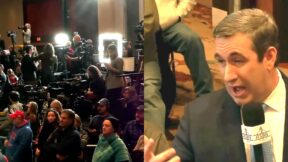CNBC Blames Trump and DOGE for Bombshell Job Loss Data: ‘Played the Biggest Part’
CNBC reporter Steve Liesman blamed President Donald Trump and DOGE czar Elon Musk for contributing to bombshell job losses in February, saying they played “the biggest part” in causing the reported layoffs.
Trump and Musk have been chainsawing federal government jobs, and Trump’s trade policy has been tanking the stock market this week, so expectations for Friday’s jobs report were already all over the place.
On top of that, Challenger, Gray & Christmas dropped a bombshell report Thursday morning that showed a 245% increase in announced layoffs from January to February, and the worst February since 2009.
The firm’s VP says it’s not just direct cuts to federal workers that make up the DOGE effect:
“Private companies announced plans to shed thousands of jobs last month, particularly in Retail and Technology. With the impact of the Department of Government Efficiency [DOGE] actions, as well as canceled Government contracts, fear of trade wars, and bankruptcies, job cuts soared in February,” said Andrew Challenger, Senior Vice President and workplace expert for Challenger, Gray & Christmas.
On Thursday’s edition of CNBC’s Squawk Box, host Andrew Ross Sorkin asked Liesman about the “DOGE effect” on the upcoming jobs report:
ANDREW ROSS SORKIN: Some new data out just announcing layoffs released. Our senior economics reporter, Steve Liesman, joins us now with more on how much DOGE could be in tomorrow’s jobs report.
What do you think, Steve?
STEVE LIESMAN: It’s a tricky story here.
But first, let me tell you, Andrew announced layoff in February is surging 245% to the highest level since the pandemic, with the Trump administration’s efforts to reduce the federal workforce planning not the only, but the biggest part in that.
The outplacement firm Challenger Gray Christmas. They’re saying that announced February layoffs, not actual layoffs, but announced ones rose to 172,000, up from just 49,000 in January.
It’s the highest monthly number since July 2020, the worst February since 2009.
It was a mix of layoffs from the government and the private sector, including government at 63,000 announced.
That includes federal workers and private government contractors. Retail 45,000 hit by cold weather as we know, and tech 22,000 with HP, Meta and Workday among the tech giants we know that announced February layoffs.
The DOGE impact was the top reason cited for job cuts, followed by market and economic conditions and then bankruptcy.
The bulk of government job cuts are likely too recent to show up in tomorrow’s jobs report. Workers won’t be counted as unemployed until their severance runs out.
But remember, roughly 30,000 federal workers. They leave their jobs monthly in a normal month. So the hiring freeze announced by President Trump on day one of his presidency, that could mean vacated jobs won’t be filled. That could create some negative numbers that could drag down the headline number even as soon as tomorrow.
Now, Evercore ISI, in a research, suggests total job losses from DOGE could be as low as 50 if the government eventually gets back to hiring, or as high as 660000.
In a worst case scenario created by what it calls DOGE policy uncertainty. They wrote “DOGE related uncertainty over contraction grants could have an additional paralyzing effect on hiring at employers exposed to those funding sources, or in need of regulatory approvals from agencies that are themselves paralyzed by DOGE review.”.
Now, most forecasters that I’m reading are settling on some kind of midpoint here between total job losses of 250 to 350,000. That’s federal job losses, or roughly 20 to 30,000 a month.
That would be a noticeable number. But the ultimate economic impact depends on whether the private sector finds job for those workers, Andrew, and can make up for those job losses.
Watch above via CNBC’s Squawk Box.




